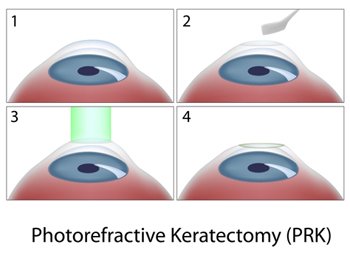Epi Contoura – Streamlight
Epi Contoura Streamlight is the latest introduction for specs removal by laser procedures. Epi Contoura Streamlight is specially designed for patients with thin corneas, delivering extraordinary results with a completely pain-less, touch-less, cut-less, blade-less, flap-less laser procedure.
Photorefractive Keratectomy (PRK) – Touch-less & Supra LASIK Procedures

In PRK, the corneal flap is not raised. Instead, the outer most covering of the cornea, called the epithelium, is completely removed to expose the underlying stromal tissue. The epithelium is like the skin of the cornea that protects its deeper layers and is also responsible for maintaining vision. The laser then reshapes the cornea as in LASIK. The epithelial heals gets self-healed in around four days, and the patient is provided with a soft contact lens to protect the cornea until the healing is completed.
PRK, LASEK, EpiLASEK, and Supra or Touch-less LASIK is called advanced surface ablations, (ASA) in which no corneal flap is raised.
Disadvantages of Surface Laser Procedures
Discomfort after the Surgery
The epithelium, when removed, requires three to five days to grow back in case of Touchless LASIK, exactly as after Photorefractive Keratotomy. It is the period of moderate post-operative discomfort which is variably described by patients as pain, discomfort, and foreign body sensation. In fact, even though no head-to-head trail compares PRK to Touchless LASIK, but most surgeons agree that the postoperative discomfort is similar after both procedures.
High Rest Period
Surface laser procedures require the use of a bandage contact lens, for a variable period of three to five days, until the epithelium grows back completely. During this period the patient cannot indulge in usual activities including work and recreation and is also advised to not drive, due to poor vision. Most doctors counsel patients about this surgical “down time” and are wary of patients’ morale dropping as the promised crystal clear vision requires additional waiting. In fact, in most cases, patients notice an improvement in their vision within the first few days after surgery, but doctors always clear that the full results will develop gradually over the course of approximately 3-6 months.
Increase in Corneal Haze
The other problem associated with the surface ablation (PRK and Touchless LASIK or SupraLASIK) is the increase in a corneal haze with the treatment of higher refractive errors. It is because the epithelium cells can never be removed completely, by either alcohol or laser and these tend to grow more haphazardly. It results in a haze in the cornea, which can be distressing to the patient.
High Risk of Corneal Ulcers
There is also an increased risk of infectious keratitis or corneal ulcer with surface ablation compared to LASIK due to the longer epithelial healing period since the protective epithelium has been removed.
Despite these obvious disadvantages, why are surface ablations still in use?
Surface ablation may be preferable to LASIK in patients with epithelial basement membrane disease and in patients who have had corneal surgery before, like corneal grafts.
They were thought to offer a distinct advantage in patients with thin corneas, but with new technologies for LASIK, this is no longer true.
Myths Regarding LASIK and ASA (PRK, LASEK, epi LASIK, Supra LASIK) Comparison in Thin Corneas
In fact, in a head to head trail to dispel this myth, Daniel Durrie MD and Stephen Slade MD, compared wavefront-guided thin-flap LASIK (SBK with a femtosecond laser-created 100 micron, 8.5mm flap) and advanced surface ablation in fellow eyes of 50 bilaterally operated patients.
They showed that during follow-up visits through the first month after surgery, the advanced surface ablation procedure was associated with more pain and lower patient satisfaction. Also, the visual outcomes were significantly better in the LASIK eyes on the first day after surgery and remained so for at least three months
The newer LASIK machines like the wavefront-guided LASIK and Contoura Vision Topography Guided LASIK correct the vision based on the eye’s unique attributes and enable the creation of thinner, narrower, and planar flaps, just like femtosecond laser LASIK. These thin flaps allow stromal ablation in even patients with thin corneas with great efficacy and safety. Most doctors agree that thinner flaps (100 µm) have a better postop visual acuity compared with thicker flaps as well. The Contoura Vision Topography Guided LASIK, in fact, provides a better quality of vision than any other laser refractive procedure, in patients with thin corneas also.
Also, most doctors are also now aware of the fact that patients with thinner corneas are NOT more susceptible to ectasia or protrusion of the cornea, since the thinner corneas have altered biomechanics, making them stronger. In fact, the most important risk factor for ectasia is keratoconus (disease and forme fruste) which must be ruled out before any laser refractive procedure. Both LASIK and ASA are contraindicated in patients with keratoconus.

